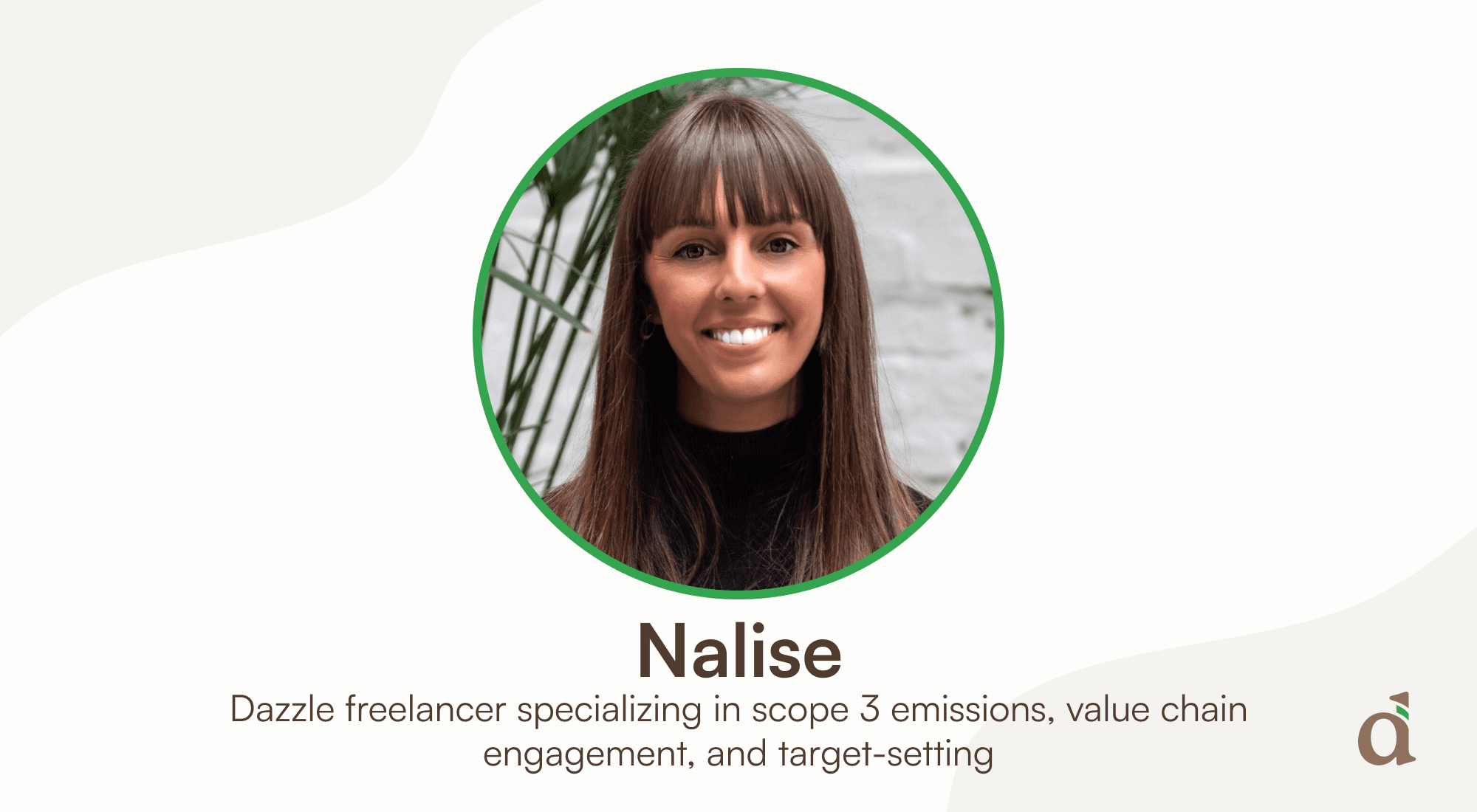About the author
This guide was written by Nalise, one of the independent sustainability experts in the Dazzle network. Nalise Hahn is an internationally experienced sustainability consultant and one of Dazzle’s go-to scope 3 experts.
Getting suppliers on board with your sustainability goals can feel overwhelming, I’ve seen it happen time and time again. Limited resources, patchy data, and varying levels of expertise make tackling Scope 3 emissions one of the trickiest parts of a sustainability strategy. But the truth is, you can’t hit your climate targets without bringing your supply chain along.
In this guide, I’m sharing practical tips from my experience helping businesses turn supplier engagement from a complex challenge into a clear, actionable plan. From getting started to keeping suppliers motivated, these are the steps that genuinely work in the real world.
1. Tackle the engagement gap with strategic prioritization

The challenge
You have hundreds — or thousands — of suppliers, but limited time and resources to get them all aligned.
Practical tip
Segment suppliers by:
- Emissions relevance (e.g, input materials, contract manufacturers).
- Spend and influence.
- Ease of engagement (e.g, existing ESG maturity).
Then focus on a manageable pilot group (e.g., top 10 suppliers by emissions).
Use this to build a replicable engagement model.
2. Overcome data gaps by guiding (not demanding) actionable inputs

The challenge
Suppliers don’t know how to measure their emissions or give you what you actually need.
Practical tip
Instead of just asking for “emissions data,” provide:
- Clear definitions of what counts as Scope 1 & 2 (for their site) or Scope 3 (for their product/operations).
- Emission factor sources you accept (e.g., EcoInvent, DEFRA, US EPA).
- Practical proxies (e.g., utility bills, fuel spend, transport distance, material types).
- Acceptable calculation methods (e.g., spend-based if activity data isn’t available, with improvement over time).
Also offer a tiered approach: allow high-level data in year 1, and build toward more granular data in year 2+.
3. Address technical capacity with pre-built tools and micro-training

The challenge
Many suppliers — especially SMEs — lack in-house expertise or tools to measure emissions.
Practical tip
Provide:
- A simple Excel emissions calculator, link to a free tool, or ability to calculate emissions as part of your company’s current carbon footprint calculator/ tool.
- Short explainer videos or supplier webinars: “How to calculate your Scope 1 and 2 in 30 minutes”.
- Industry-specific emission factor cheat sheets.
- FAQs on units, boundaries, and reporting cycles.
4. Turn compliance into opportunity through procurement levers

The challenge
Suppliers deprioritize emissions when they see no commercial benefit.
Practical tip
Make emissions performance commercially relevant by:
- Incorporating carbon disclosure or decarbonization roadmaps into RFQs and contracts.
- Linking participation to preferred supplier status.
- Awarding bonus points for validated product carbon footprints or SBTi targets.
- Clearly communicating your own targets and how their data helps you stay compliant (e.g., CSRD, SBTi, PPN 06/21).
5. Reduce resistance by building trust and transparency

The challenge
Suppliers fear being penalized for high emissions or exposing sensitive information.
Practical tip
- Be clear that data is used for collective improvement, not punishment.
- Share your own Scope 3 goals and how you’re tackling your footprint.
- Offer anonymized benchmarks (e.g., “typical carbon footprint of X per unit for your sector”).
- Clarify how you will use their data, especially if it feeds into product-level LCA, SBTi, or investor reporting.
6. Drive continuous improvement by creating a feedback loop

The challenge
Once data is submitted, the conversation often ends — until next year.
Practical tip
Keep suppliers engaged by:
- Sharing individualized dashboards showing their emissions over time.
- Offering feedback on data quality and completeness.
- Setting joint decarbonization goals or co-investing in solutions (e.g., switching materials, improving logistics).
- Celebrating success: recognize low-carbon innovations or reductions in your supplier newsletter or website.
Turning challenges into progress

Engaging suppliers doesn’t have to feel overwhelming. With the right approach and tools, it can become an opportunity to strengthen relationships, drive real progress on sustainability goals, and make Scope 3 emissions more manageable.
Success comes from clear communication, consistent support, and a plan that keeps suppliers motivated every step of the way.


